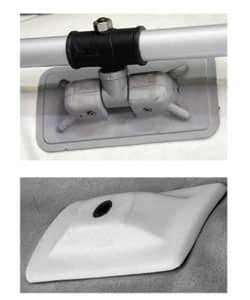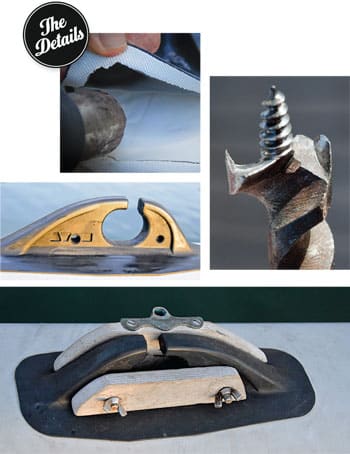
Modified Dinghy Oarlocks
As usual in winter, the trades whistled with determination through the anchorage at Praia, on Santiago, one of the islands of Cape Verde. Looking out the companionway, I saw a couple in a dinghy let go of their sloop. A moment later, their outboard died. They began paddling with the short, light oars that came as standard equipment with their dinghy, but the blustery wind continued to blow them westward. The next stop to leeward was Barbados.
Not having time to put a motor on our inflatable, I jumped in and took off rowing after them. I hoped I could at least bring the people back. As it was, thanks to our long real oars in real oarlocks, I managed with some effort and perseverance to tow them back to their boat.
In less dramatic, more mundane circumstances, like going to a not-too-distant shore or exploring a creek with some wildlife, my wife, Nancy, and I prefer rowing just to avoid the outboard motor racket. Also, rowing our inflatable for an hour, especially against wind or current, gives us a pretty mean morning workout.
Our dinghy at the time was an Avon inflatable, and the collapsible oars that came with it weren’t much better than the ones that led to our anchorage mates’ misadventure. But by taking advantage of the hard-rubber oar holders that Avon uses, I made a modification that allowed me to use real, 7-foot-6-inch oars. The Avon oar holders have a large footprint, which lends tenacious holding power to the glued joint. However, the slotted opening for the oars flexes too much to use the long oars necessary to develop a powerful rowing stroke. I decided the rubber could be stiffened and reinforced by clamping it between two pieces of wood. Two bolts through the rubber would hold them together tightly, and bronze oarlock sockets could then be screwed to the outer pieces of the wood clamps. To drill the holes in the rubber I used a guided wood bit known as an auger bit.

| |Failure-Prone Locks Unfortunately, the standard equipment on most inflatables (pictured) isn’t designed for powerful rowing.|
If your dinghy has a different oarlock design, this whole operation can be performed on a variety of other inflatable boats as long as the fabric is Hypalon-reinforced. This is what I had to do on our latest inflatable, which came with the boat we bought. First you need to acquire a pair of the Avon-style oarlocks, which are available at Defender, or you can even remove them from an old Avon inflatable.
Next you’ll need to remove the oarlocks that came on your inflatable. You should work on a fully inflated boat. Use a heat gun to soften the original glue, then pull off the fittings. The only tricky situation arises when a manufacturer has installed oar holders over an air-tube glue seam. It can still be done by warming the piece to be removed very slowly and pulling it all off before the seam underneath gets hot.
Pulling the fitting off may leave blobs of old glue on the surface. To remove it, use mineral spirits or 3M Adhesive Remover. You must sand the fabric before gluing. Put the new Avon oarlocks in the right spots, mark the outlines, then place masking tape to border the areas to be sanded. The more abrasion, the better, so use 60-grit sandpaper on a small sanding block. Abrade the undersides of the new oarlocks as well. Refresh the masking tape, then wipe everything clean with toluene or a similar solvent.

| |New Lock Prep If you want to replace your inflatable’s oarlocks with a more sturdy style, a heat gun (top left) will help to soften the adhesive so you can remove the old locks. Then use an auger bit (top right) to drill the holes in the Avon-style oarlock (middle, left). I used a special glue to firmly attach each new, modified rubber oarlock, which is reinforced with wood and now serves as the base for the traditional bronze oarlock socket (bottom).|
Cut off a third or so of the bristles of a chip brush to stiffen them up. Stiff bristles facilitate the application of glue in thin coats. Mix well a small amount of two-part glue for Hypalon, then brush on a thin coat of glue to each surface. Let dry completely, then repeat the glue application with fresh, trimmed brushes. Let dry until the glue is tacky—usually 10 to 15 minutes, depending on the ambient temperature. Then, following the masking-tape guides, put the new oarlocks on; press down repeatedly to purge any air bubbles. Do this very carefully. Get the glued areas to line up perfectly because once they touch, you won’t be able to adjust them.
The oars you receive with any inflatable dinghy are simply too short and flimsy for rowing in anything but calm water. You’ll have to find solid wooden oars that can be stowed inside the dinghy. Sometimes it’s possible to buy really sturdy two-part oars that make stowing easy. Use the longest oars you can row without hitting your knees when the blades come out of the water before the next stroke. On our 10-foot-2-inch dinghy, I use 7-foot-6-inch oars, and they fit inside the boat lying flat on the floorboards and out of the way. To make our oars always ready for action, I’ve slipped on round horn, or closed, oarlocks. I then installed anti-chafe collars, which also prevent the oarlocks from falling off. Just in case an oar falls in the water, I’ve attached a long, thin lanyard to each oar to keep it from floating away.
All these operations present no problems as long as you work with Hypalon-reinforced fabrics. PVC-fabric inflatables are put together by heat welding, and the boats can have some longevity problems with the seams. Once the seams let go, the boat is practically impossible to repair by gluing. Two-part glues designated for PVC will help only temporarily with repairs to small punctures.
As for converting a PVC boat to different oarlocks, I tried the heat-gun method as an experiment on a discarded boat. It took a very long time and a lot of heat to pull off a fitting. The PVC fabric seemed to be resistant to abrasion with sandpaper, and a well-abraded surface is essential to successful gluing. Don’t take chances with modifying an inflatable made of PVC fabric.
This article, “Row Your (Inflatable) Boat,” first appeared in the July 2013 issue of Cruising World_._








